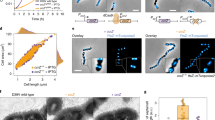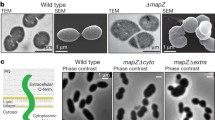Abstract
Bacterial cell division is a highly controlled process regulated accurately by a diverse array of proteins spatially and temporally working together. Among these proteins, FtsZ is recognized as a cytoskeleton protein because it can assemble into a ring-like structure called Z-ring at midcell. Z-ring recruits downstream proteins, thus forming a multiprotein complex termed the divisome. When the Z-ring scaffold is established and the divisome matures, peptidoglycan (PG) biosynthesis and chromosome segregation are triggered. In this review, we focus on multiple interactions between FtsZ and its accessory proteins in bacterial cell cytokinesis, including FtsZ localization, Z-ring formation and stabilization, PG biosynthesis, and chromosome segregation. Understanding the interactions among these proteins may help discover superior targets on treating bacterial infectious diseases.


Similar content being viewed by others
References
Arends SJ, Kustusch RJ, Weiss DS (2009) ATP-binding site lesions in FtsE impair cell division. J Bacteriol 191(12):3772–3784
Berezuk AM et al (2018) Outer membrane lipoprotein RlpA is a novel periplasmic interaction partner of the cell division protein FtsK in Escherichia coli. Sci Rep 8(1):12933
Bhattacharya A et al (2015) ZapC promotes assembly and stability of FtsZ filaments by binding at a different site on FtsZ than ZipA. Int J Biol Macromol 81:435–442
Bisson-Filho AW et al (2017) Treadmilling by FtsZ filaments drives peptidoglycan synthesis and bacterial cell division. Science 355(6326):739–743
Blasios V et al (2013) Genetic and biochemical characterization of the MinC-FtsZ interaction in Bacillus subtilis. PLoS One 8(4):e60690
Boes A et al (2019) Regulation of the peptidoglycan polymerase activity of PBP1b by antagonist actions of the core divisome proteins FtsBLQ and FtsN. MBio 10(1):e01912-18
Buss JA et al (2017) ZapA and ZapB form an FtsZ-independent structure at midcell. Mol Microbiol 104(4):652–663
Cabre EJ et al (2015) The nucleoid occlusion SlmA protein accelerates the disassembly of the FtsZ protein polymers without affecting their GTPase activity. PLoS One 10(5):e0126434
Cho H et al (2011) Nucleoid occlusion factor SlmA is a DNA-activated FtsZ polymerization antagonist. Proc Natl Acad Sci USA 108(9):3773–3778
Choi H et al (2016) Structural and biochemical studies reveal a putative FtsZ recognition site on the Z-ring stabilizer ZapD. Mol Cells 39(11):814–820
Condon S et al (2018) The FtsLB subcomplex of the bacterial divisome is a tetramer with an uninterrupted FtsL helix linking the transmembrane and periplasmic regions. J Biol Chem 293(5):1623–1641
Conti J, Viola MG, Camberg JL (2015) The bacterial cell division regulators MinD and MinC form polymers in the presence of nucleotide. FEBS Lett 589(2):201–206
Conti J, Viola MG, Camberg JL (2018) FtsA reshapes membrane architecture and remodels the Z-ring in Escherichia coli. Mol Microbiol 107(4):558–576
den Blaauwen T, Hamoen LW, Levin PA (2017) The divisome at 25: the road ahead. Curr Opin Microbiol 36:85–94
Dubey A, Priyadarshini R (2018) Amidase activity is essential for medial localization of AmiC in Caulobacter crescentus. Curr Genet 64(3):661–675
Durand-Heredia JM et al (2011) Identification and characterization of ZapC, a stabilizer of the FtsZ ring in Escherichia coli. J Bacteriol 193(6):1405–1413
Ercoli G et al (2015) LytM proteins play a crucial role in cell separation, outer membrane composition, and pathogenesis in nontypeable Haemophilus influenzae. MBio 6(2):e02575
Espeli O et al (2012) A MatP-divisome interaction coordinates chromosome segregation with cell division in E. coli. EMBO J 31(14):3198–3211
Fraipont C et al (2011) The integral membrane FtsW protein and peptidoglycan synthase PBP3 form a subcomplex in Escherichia coli. Microbiology 157(Pt 1):251–259
Galli E, Gerdes K (2010) Spatial resolution of two bacterial cell division proteins: ZapA recruits ZapB to the inner face of the Z-ring. Mol Microbiol 76(6):1514–1526
Galli E, Gerdes K (2012) FtsZ-ZapA-ZapB interactome of Escherichia coli. J Bacteriol 194(2):292–302
Galli E et al (2017) Fast growth conditions uncouple the final stages of chromosome segregation and cell division in Escherichia coli. PLoS Genet 13(3):e1006702
Grainge I (2010) FtsK–a bacterial cell division checkpoint? Mol Microbiol 78(5):1055–1057
Guan F et al (2018) Lateral interactions between protofilaments of the bacterial tubulin homolog FtsZ are essential for cell division. Elife 7:35578
Hale CA et al (2011) Identification of Escherichia coli ZapC (YcbW) as a component of the division apparatus that binds and bundles FtsZ polymers. J Bacteriol 193(6):1393–1404
Huang KH et al (2016) Characterization of the FtsZ C-Terminal variable (CTV) region in Z-ring assembly and interaction with the Z-ring stabilizer ZapD in E. coli cytokinesis. PLoS One 11(4):e0153337
Huecas S et al (2017) Self-organization of FtsZ polymers in solution reveals spacer role of the disordered C-terminal tail. Biophys J 113(8):1831–1844
Kennedy SP, Chevalier F, Barre FX (2008) Delayed activation of Xer recombination at dif by FtsK during septum assembly in Escherichia coli. Mol Microbiol 68(4):1018–1028
Krupka M, Margolin W (2018) Unite to divide: oligomerization of tubulin and actin homologs regulates initiation of bacterial cell division. F1000Res 7:235
Krupka M et al (2017) Escherichia coli FtsA forms lipid-bound minirings that antagonize lateral interactions between FtsZ protofilaments. Nat Commun 8:15957
Krupka M et al (2019) Escherichia coli ZipA organizes FtsZ polymers into dynamic ring-like protofilament structures. MBio 9(3):e01008-18
Kureisaite-Ciziene D et al (2018) Structural analysis of the interaction between the bacterial cell division proteins FtsQ and FtsB. MBio 9(5):e01346-18
LaBreck CJ et al (2019) MinC N- and C-domain interactions modulate FtsZ assembly, division site selection, and MinD-dependent oscillation in Escherichia coli. J Bacteriol 201(4):e00374-18
Liu B et al (2015) Roles for both FtsA and the FtsBLQ subcomplex in FtsN-stimulated cell constriction in Escherichia coli. Mol Microbiol 95(6):945–970
Loose M et al (2011) Min protein patterns emerge from rapid rebinding and membrane interaction of MinE. Nat Struct Mol Biol 18(5):577–583
Low HH, Moncrieffe MC, Lowe J (2004) The crystal structure of ZapA and its modulation of FtsZ polymerisation. J Mol Biol 341(3):839–852
Mannik J et al (2016) The role of MatP, ZapA and ZapB in chromosomal organization and dynamics in Escherichia coli. Nucleic Acids Res 44(3):1216–1226
Matsui T et al (2014) Structural change in FtsZ Induced by intermolecular interactions between bound GTP and the T7 loop. J Biol Chem 289(6):3501–3509
Misra HS et al (2018) Interdependence of bacterial cell division and genome segregation and its potential in drug development. Microbiol Res 208:12–24
Mizuuchi K, Vecchiarelli AG (2018) Mechanistic insights of the Min oscillator via cell-free reconstitution and imaging. Phys Biol 15(3):031001
Nogueira ML et al (2015) Backbone and side chain NMR assignments of Geobacillus stearothermophilus ZapA allow identification of residues that mediate the interaction of ZapA with FtsZ. Biomol NMR Assign 9(2):387–391
Ortiz C et al (2015) Crystal structure of the Z-ring associated cell division protein ZapC from Escherichia coli. FEBS Lett 589(24 Pt B):3822–3828
Ortiz C et al (2016) The keepers of the ring: regulators of FtsZ assembly. FEMS Microbiol Rev 40(1):57–67
Pang T et al (2017) The nucleoid occlusion factor Noc controls DNA replication initiation in Staphylococcus aureus. PLoS Genet 13(7):e1006908
Park KT et al (2017) MinE conformational dynamics regulate membrane binding, MinD interaction, and Min oscillation. Proc Natl Acad Sci USA 114(29):7497–7504
Park KT et al (2018) MinC and FtsZ mutant analysis provides insight into MinC/MinD-mediated Z ring disassembly. J Biol Chem 293(16):5834–5846
Perez AJ et al (2019) Movement dynamics of divisome proteins and PBP2x:FtsW in cells of Streptococcus pneumoniae. Proc Natl Acad Sci USA 116(8):3211–3220
Pichoff S, Lutkenhaus J (2005) Tethering the Z ring to the membrane through a conserved membrane targeting sequence in FtsA. Mol Microbiol 55(6):1722–1734
Pichoff S et al (2012) FtsA mutants impaired for self-interaction bypass ZipA suggesting a model in which FtsA’s self-interaction competes with its ability to recruit downstream division proteins. Mol Microbiol 83(1):151–167
Pichoff S, Du S, Lutkenhaus J (2018) Disruption of divisome assembly rescued by FtsN-FtsA interaction in Escherichia coli. Proc Natl Acad Sci USA 115(29):E6855–E6862
Ramirez-Diaz DA et al (2018) Treadmilling analysis reveals new insights into dynamic FtsZ ring architecture. PLoS Biol 16(5):e2004845
Roach EJ et al (2016) Structure and mutational analyses of Escherichia coli ZapD reveal charged residues involved in FtsZ filament bundling. J Bacteriol 198(11):1683–1693
Roseboom W et al (2018) Mapping the contact sites of the escherichia coli division-initiating proteins FtsZ and ZapA by BAMG cross-linking and site-directed mutagenesis. Int J Mol Sci 19(10):2928
Rued BE et al (2019) Structure of the large extracellular loop of FtsX and Its Interaction with the essential peptidoglycan hydrolase PcsB in Streptococcus pneumoniae. MBio 10(1):e02622-18
Ruiz-Martinez A et al (2018) Efficient models of polymerization applied to FtsZ ring assembly in Escherichia coli. Proc Natl Acad Sci USA 115(19):4933–4938
Schoenemann KM et al (2018) Gain-of-function variants of FtsA form diverse oligomeric structures on lipids and enhance FtsZ protofilament bundling. Mol Microbiol 109(5):676–693
Schumacher MA, Zeng W (2016) Structures of the nucleoid occlusion protein SlmA bound to DNA and the C-terminal domain of the cytoskeletal protein FtsZ. Proc Natl Acad Sci USA 113(18):4988–4993
Schumacher MA et al (2016) Structural and functional analyses reveal insights into the molecular properties of the Escherichia coli Z ring stabilizing protein. ZapC. J Biol Chem 291(5):2485–2498
Schumacher MA et al (2017) Structure of the Z ring-associated protein, ZapD, bound to the C-terminal domain of the tubulin-like protein, FtsZ, suggests mechanism of Z ring stabilization through FtsZ cross-linking. J Biol Chem 292(9):3740–3750
Sherratt DJ et al (2010) The Escherichia coli DNA translocase FtsK. Biochem Soc Trans 38(2):395–398
Shih YL, Zheng M (2013) Spatial control of the cell division site by the Min system in Escherichia coli. Environ Microbiol 15(12):3229–3239
Soderstrom B, Daley DO (2017) The bacterial divisome: more than a ring? Curr Genet 63(2):161–164
Soderstrom B, Chan H, Daley DO (2019) Super-resolution images of peptidoglycan remodelling enzymes at the division site of Escherichia coli. Curr Genet 65(1):99–101
Sundararajan K, Goley ED (2017) The intrinsically disordered C-terminal linker of FtsZ regulates protofilament dynamics and superstructure in vitro. J Biol Chem 292(50):20509–20527
Taguchi A et al (2019) FtsW is a peptidoglycan polymerase that is functional only in complex with its cognate penicillin-binding protein. Nat Microbiol 4:587–594
Tonthat NK et al (2013) SlmA forms a higher-order structure on DNA that inhibits cytokinetic Z-ring formation over the nucleoid. Proc Natl Acad Sci USA 110(26):10586–10591
Vega DE, Margolin W (2019) Direct interaction between the Two Z ring membrane anchors FtsA and ZipA. J Bacteriol 201(4):e00579-18
Villanelo F et al (2011) A model for the Escherichia coli FtsB/FtsL/FtsQ cell division complex. BMC Struct Biol 11:28
Viola MG et al (2017) Proteolysis-dependent remodeling of the tubulin homolog FtsZ at the division septum in Escherichia coli. PLoS One 12(1):e0170505
Wang S, Wingreen NS (2013) Cell shape can mediate the spatial organization of the bacterial cytoskeleton. Biophys J 104(3):541–552
Weiss DS (2015) Last but not least: new insights into how FtsN triggers constriction during Escherichia coli cell division. Mol Microbiol 95(6):903–909
Wissel MC, Weiss DS (2004) Genetic analysis of the cell division protein FtsI (PBP3): amino acid substitutions that impair septal localization of FtsI and recruitment of FtsN. J Bacteriol 186(2):490–502
Woldemeskel SA et al (2017) A conserved coiled-coil protein pair focuses the cytokinetic Z-ring in Caulobacter crescentus. Mol Microbiol 105(5):721–740
Yang DC et al (2011) An ATP-binding cassette transporter-like complex governs cell-wall hydrolysis at the bacterial cytokinetic ring. Proc Natl Acad Sci USA 108(45):E1052–E1060
Acknowledgements
This work was supported by grants from the National Natural Science Foundation of China (Nos. 81673477, 81471997 and 81001460).
Author information
Authors and Affiliations
Corresponding author
Additional information
Communicated by M. Kupiec.
Publisher's Note
Springer Nature remains neutral with regard to jurisdictional claims in published maps and institutional affiliations.
Rights and permissions
About this article
Cite this article
Wang, M., Fang, C., Ma, B. et al. Regulation of cytokinesis: FtsZ and its accessory proteins. Curr Genet 66, 43–49 (2020). https://doi.org/10.1007/s00294-019-01005-6
Received:
Revised:
Accepted:
Published:
Issue Date:
DOI: https://doi.org/10.1007/s00294-019-01005-6




